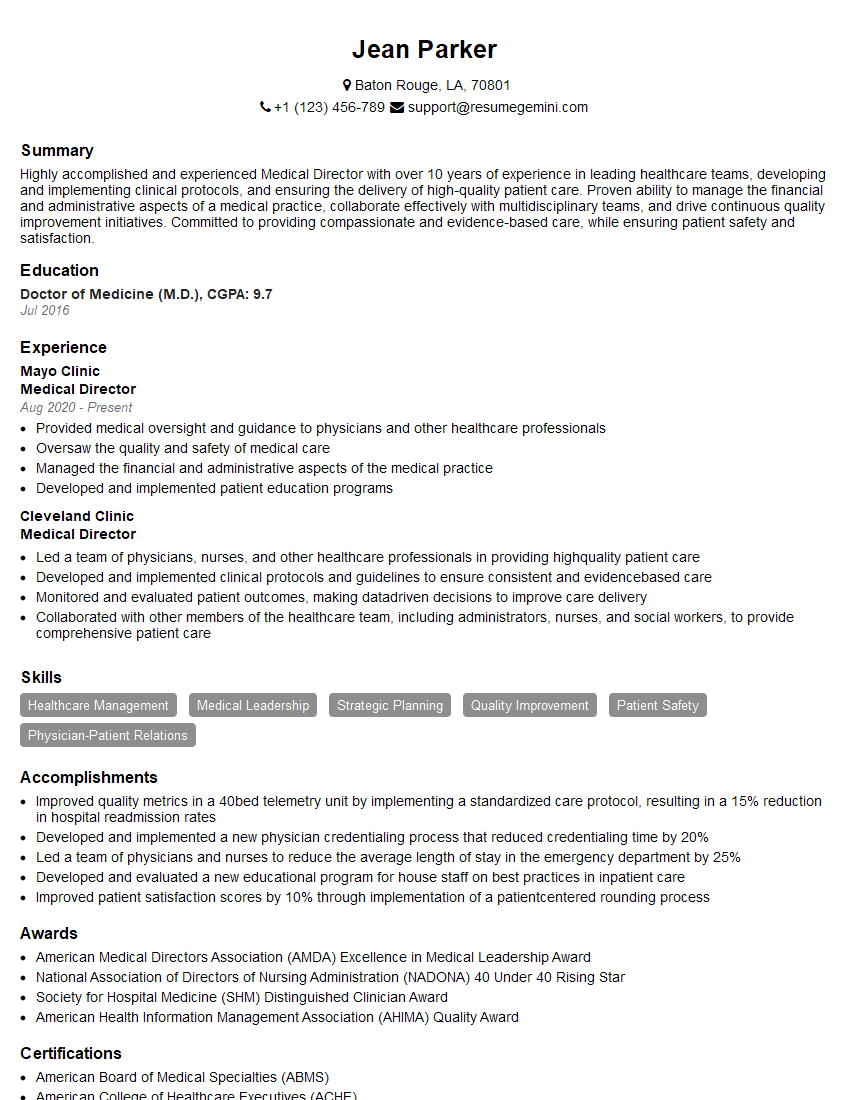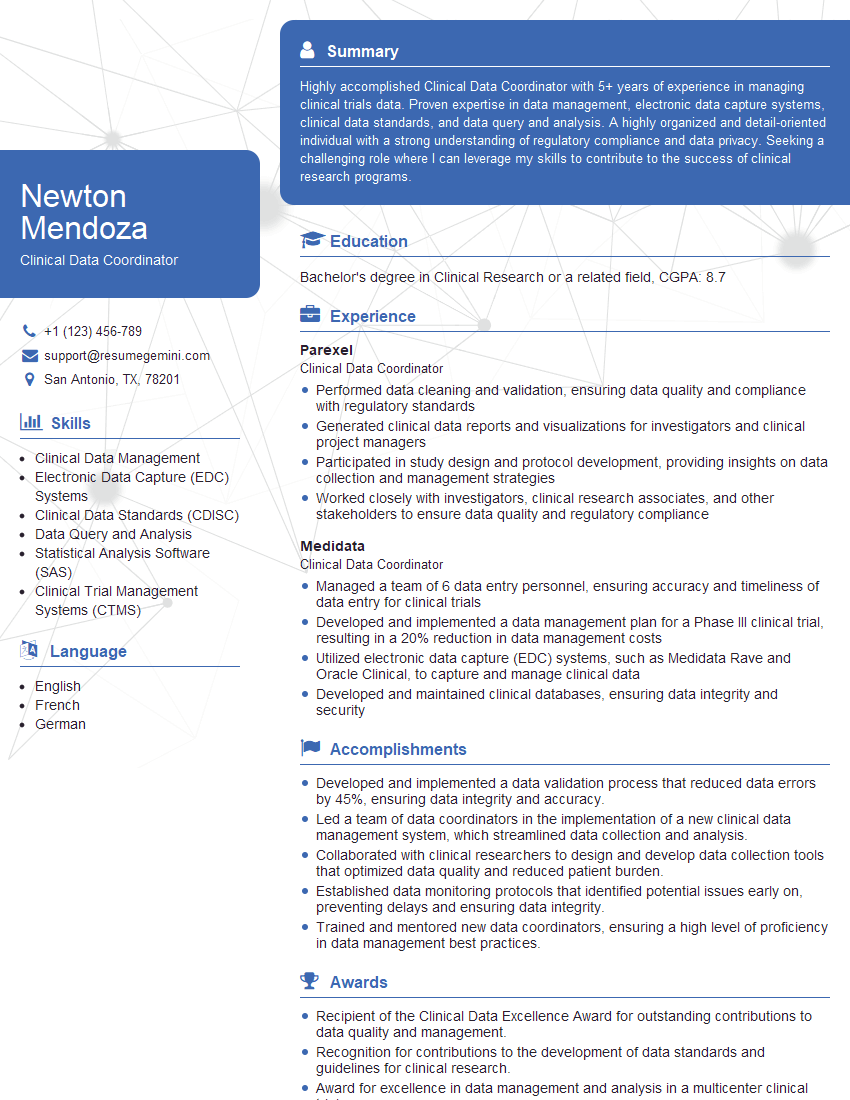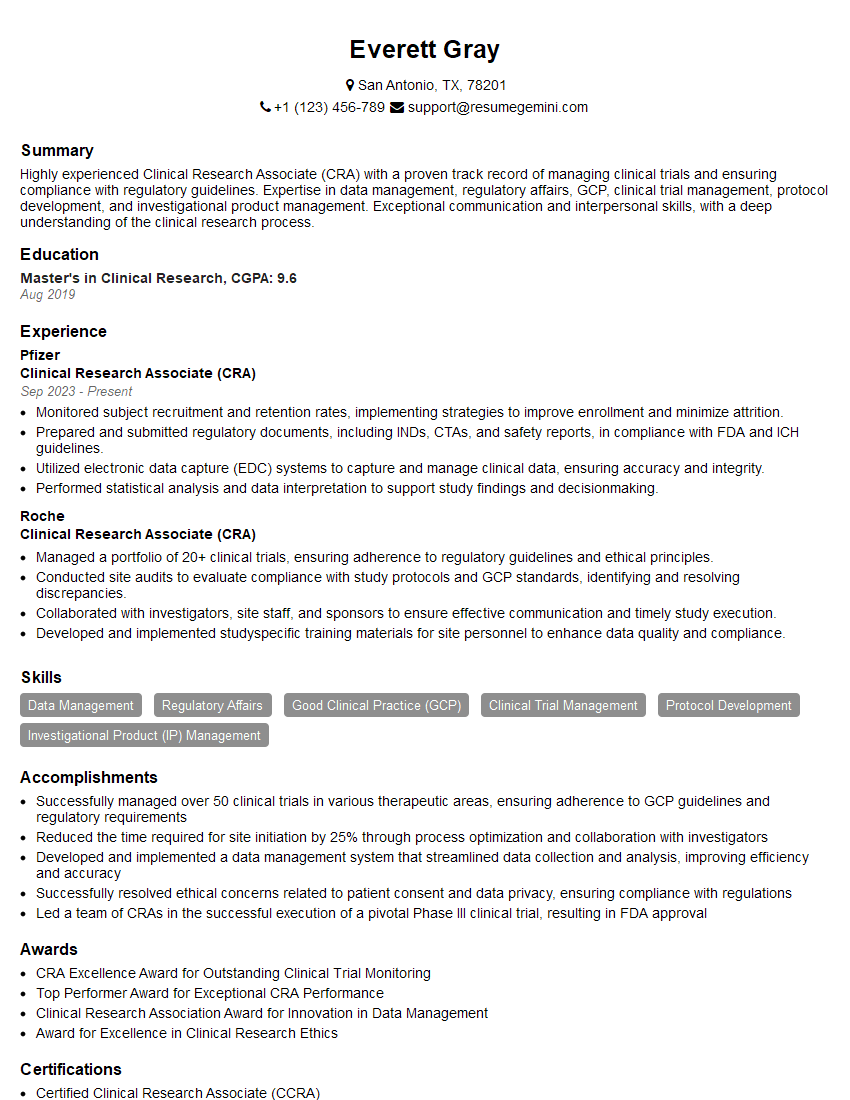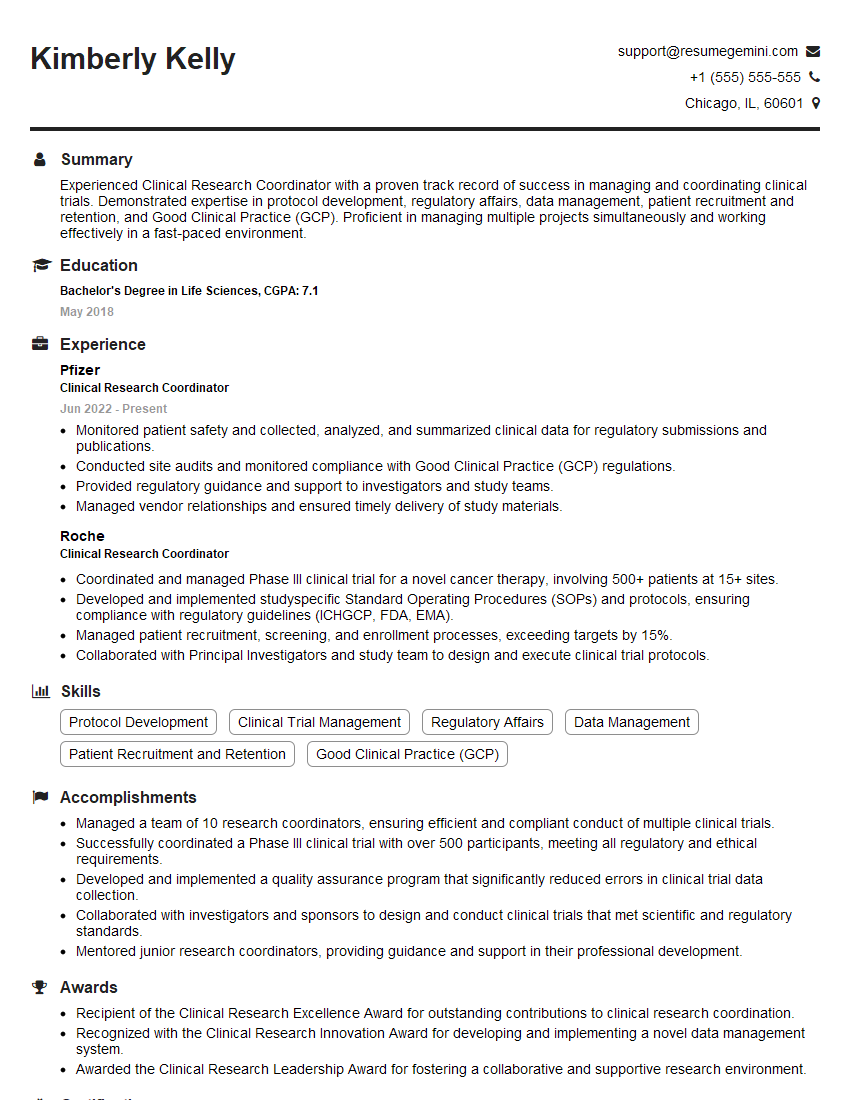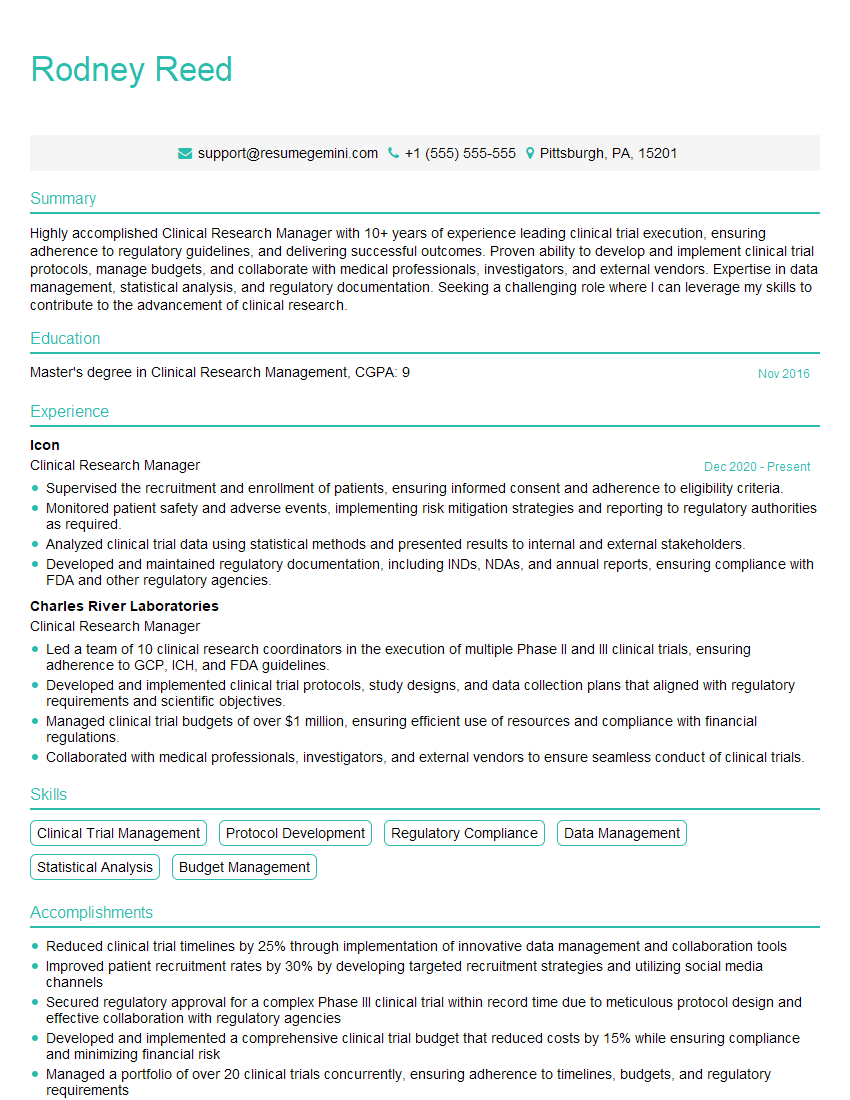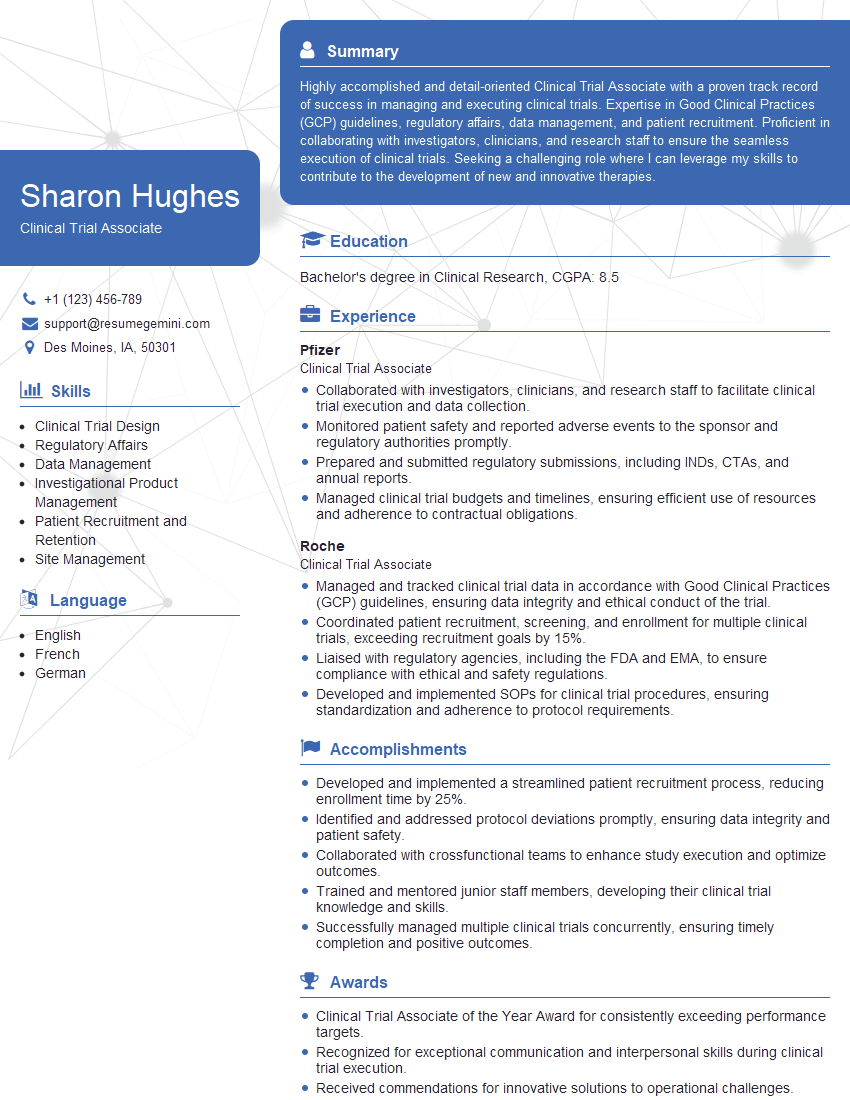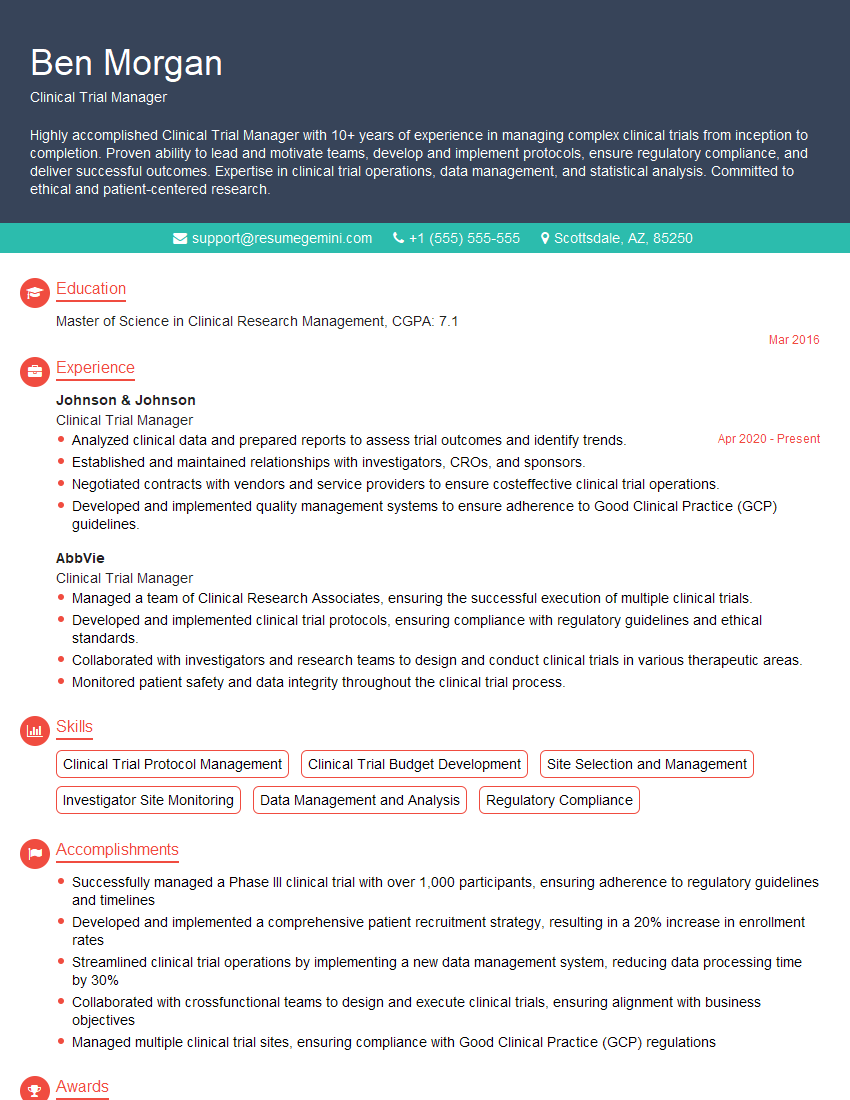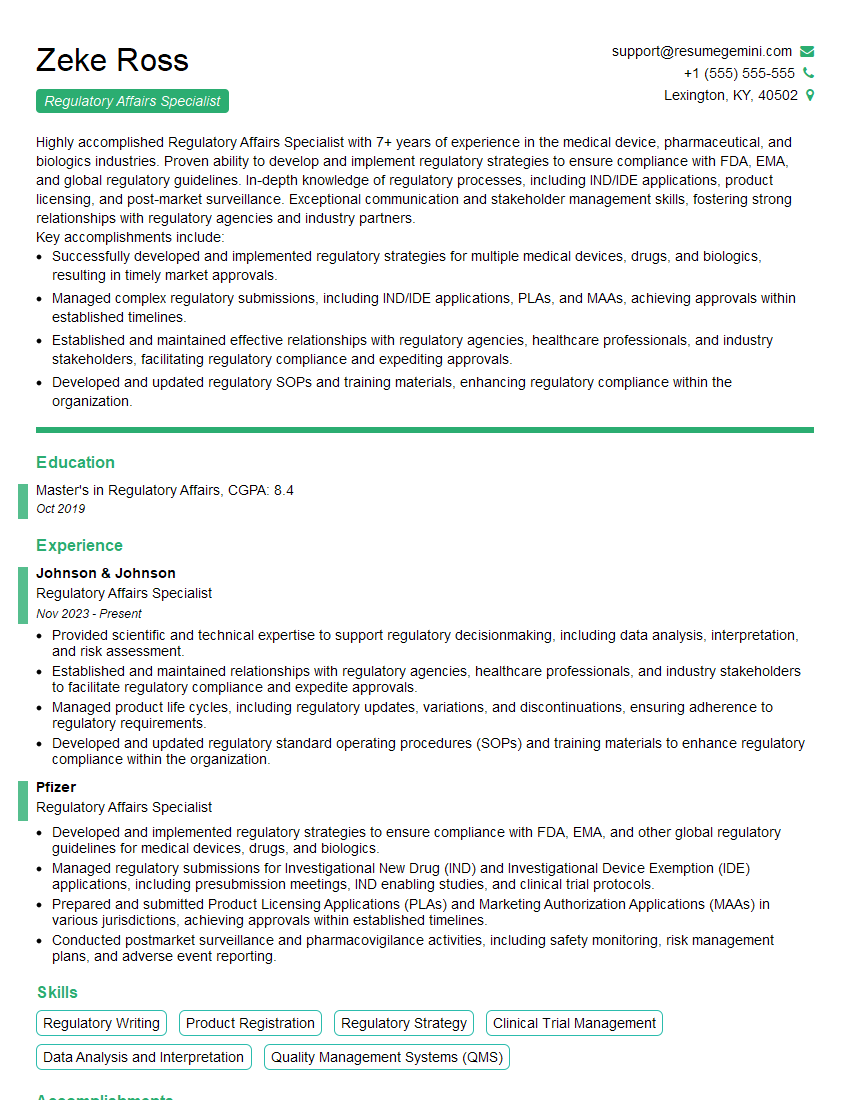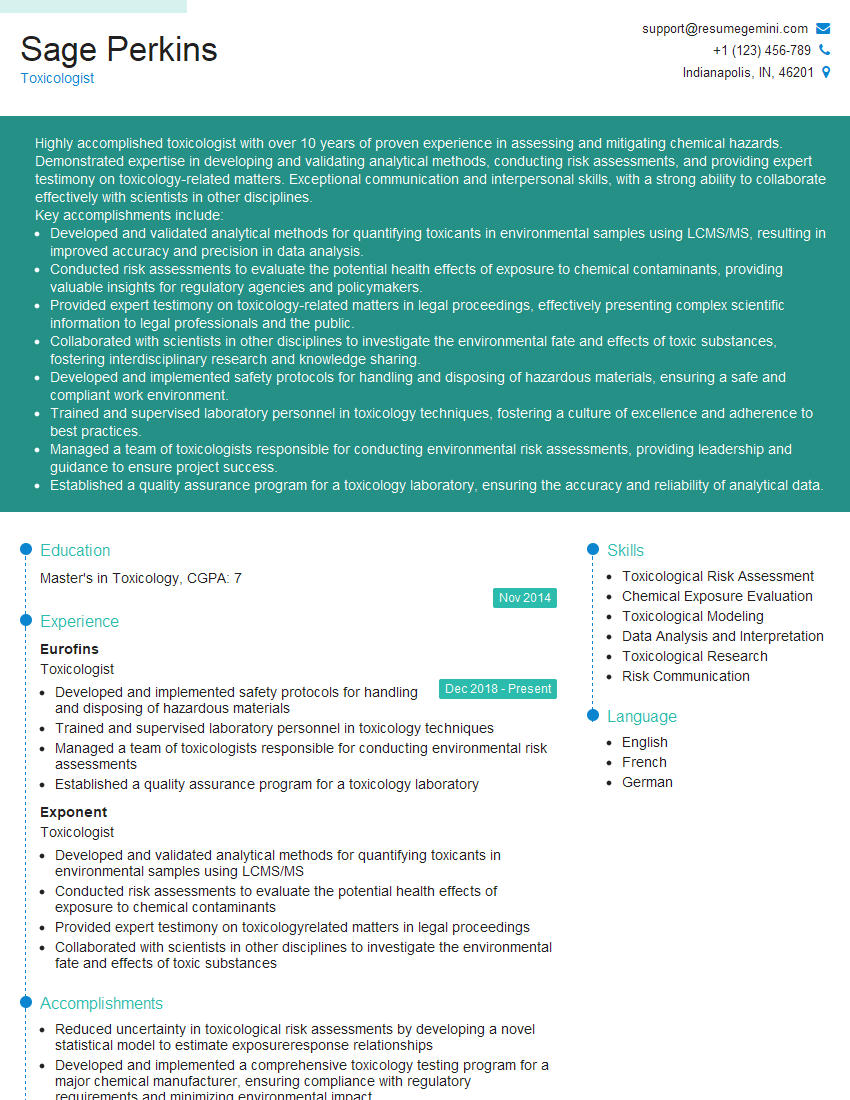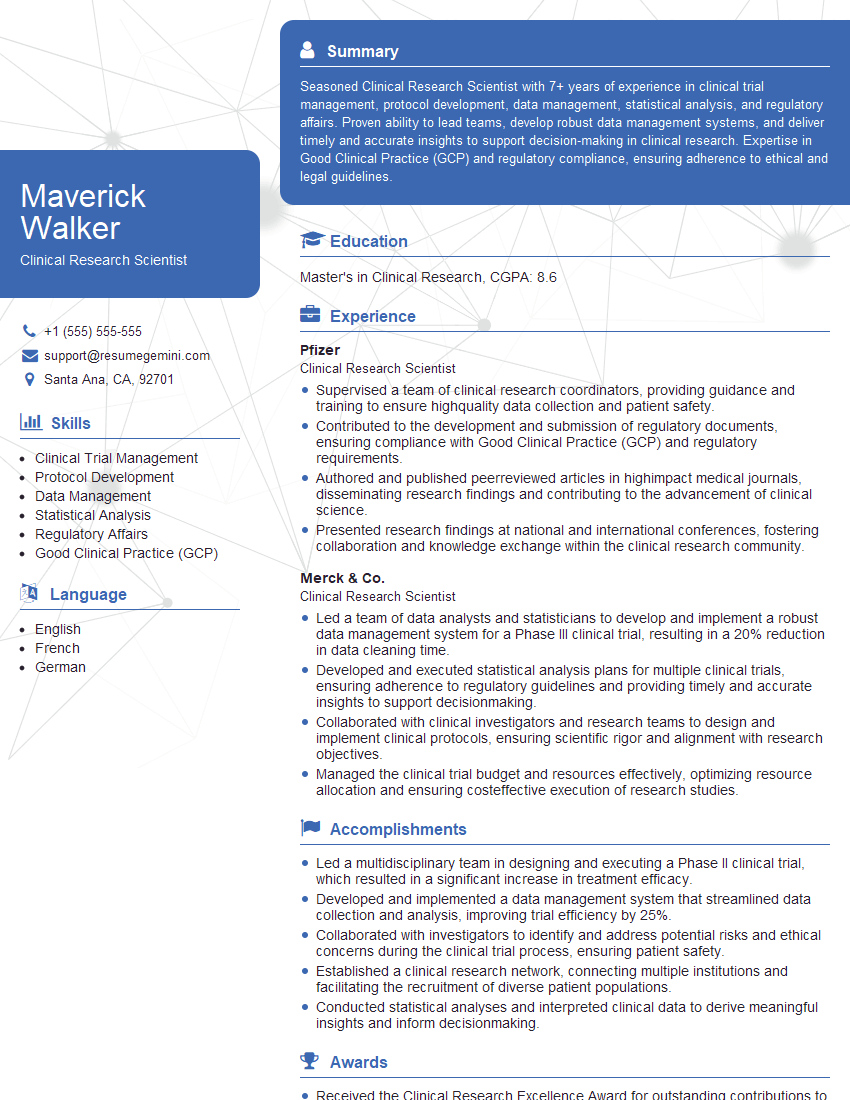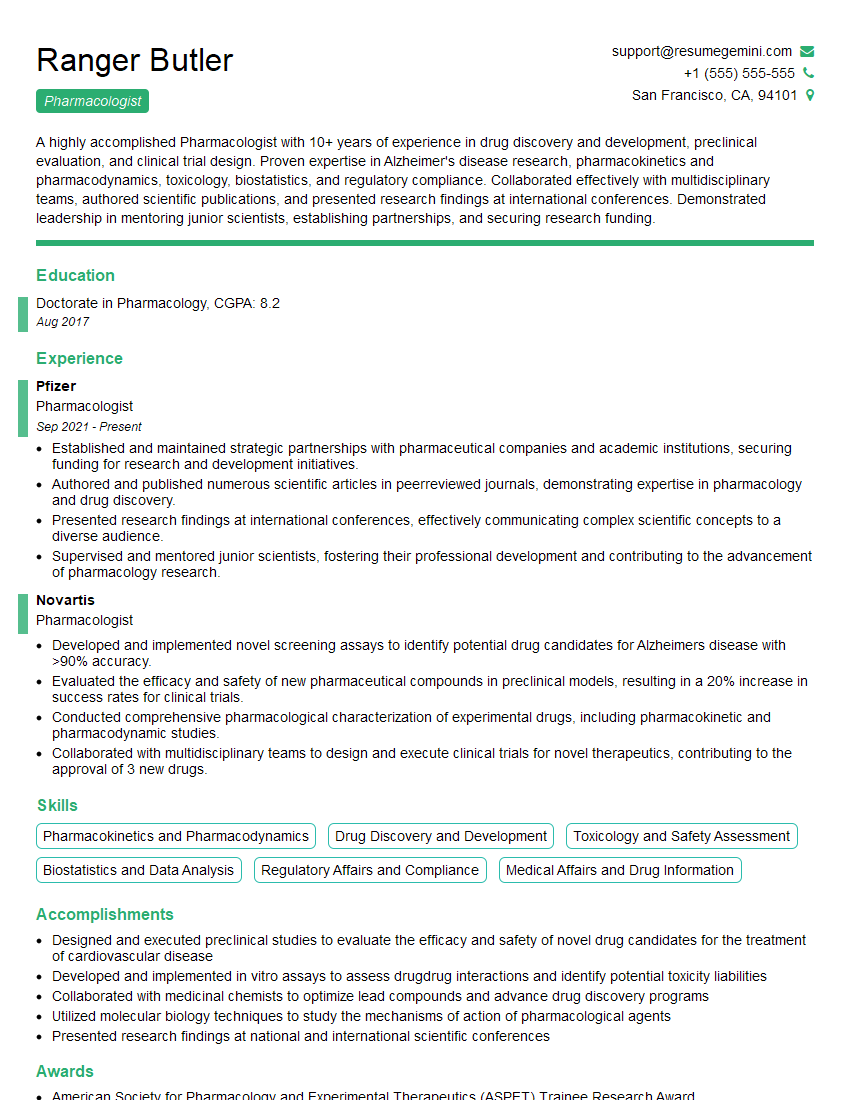The thought of an interview can be nerve-wracking, but the right preparation can make all the difference. Explore this comprehensive guide to Clinical Research and Trials interview questions and gain the confidence you need to showcase your abilities and secure the role.
Questions Asked in Clinical Research and Trials Interview
Q 1. Explain the phases of clinical trials and their objectives.
Clinical trials are conducted in phases, each with specific objectives. Think of it like building a house: you wouldn’t start painting before laying the foundation. Each phase progressively builds on the previous one, ensuring safety and efficacy.
- Phase 1: This initial phase focuses on safety. A small group of healthy volunteers receive the drug to assess its safety profile, tolerance, pharmacokinetics (how the body processes the drug), and pharmacodynamics (how the drug affects the body). For example, researchers might monitor blood pressure, heart rate, and potential side effects very closely.
- Phase 2: Once safety is established, Phase 2 moves to assessing efficacy. A larger group of patients with the target condition receive the drug to determine its effectiveness and identify optimal dosages. This phase often involves rigorous monitoring and data collection to see if the treatment is actually working and is showing improvements in the target symptoms. For example, in a trial for a new cancer drug, researchers might track tumor size and patient survival rates.
- Phase 3: This large-scale trial compares the new drug to existing treatments or a placebo (an inactive substance). Thousands of patients participate to confirm efficacy, monitor side effects, and compare it to the standard of care. A statistically significant improvement needs to be demonstrated to support regulatory approval. For example, if a new drug is being developed to treat hypertension, Phase 3 would compare its efficacy in lowering blood pressure compared to an existing antihypertensive drug.
- Phase 4: Post-market surveillance. After regulatory approval, Phase 4 trials continue to monitor the long-term effects, efficacy, and safety of the drug in a broader population. This is where rare or delayed side effects might be uncovered. For example, researchers might continue to monitor patients taking a newly approved drug for years to identify any long-term health impacts.
Q 2. Describe the ICH-GCP guidelines and their importance.
ICH-GCP (International Council for Harmonisation – Good Clinical Practice) guidelines are a set of ethical and scientific quality standards designed to protect the rights, safety, and well-being of trial participants and ensure the credibility of clinical trial data. They’re essential for ensuring that research is conducted ethically and produces reliable results that can be trusted by regulators and healthcare providers.
These guidelines cover many aspects of clinical trials, including:
- Informed Consent: Participants must understand the trial’s purpose, procedures, risks, and benefits before they can participate.
- Data Management: Ensuring accurate, complete, and verifiable data through proper record-keeping, documentation, and data validation. This includes establishing clear procedures for handling data entry, corrections, and queries.
- Monitoring and Auditing: Regular monitoring of the trial by independent monitors to ensure adherence to GCP and protocol. Audits review the trial’s conduct to verify compliance.
- Investigator Responsibilities: Defining the roles and responsibilities of the principal investigator and other research personnel.
- Safety Reporting: Establishing procedures for reporting adverse events (unexpected or unintended side effects) to ensure participant safety and regulatory compliance.
Think of ICH-GCP guidelines as a roadmap ensuring that research is conducted ethically and scientifically sound, leading to reliable results. Non-compliance can lead to serious consequences including regulatory action and retraction of study findings.
Q 3. What are the key differences between observational studies and interventional trials?
Observational studies and interventional trials differ fundamentally in how they collect data. In interventional trials (like clinical trials), researchers actively intervene by administering a treatment or intervention to participants and observe the effects. Observational studies, however, only observe participants, measuring exposures and outcomes without intervention.
- Interventional Trials: Researchers assign participants to different groups (e.g., treatment and control groups) and actively administer a treatment or intervention. They control the exposure. A classic example is a randomized controlled trial (RCT) comparing a new drug to a placebo.
- Observational Studies: Researchers observe participants without intervening, measuring exposures and outcomes naturally. For example, a cohort study might follow a group of smokers and non-smokers over time to observe the incidence of lung cancer. The researcher does not dictate smoking status.
The key difference lies in the level of control. Interventional trials have high control over the exposure, allowing for stronger causal inferences (but potential ethical and practical limitations). Observational studies have less control, leading to potentially confounding factors (but may be more feasible and ethical for certain research questions).
Q 4. How do you ensure data integrity in clinical trials?
Data integrity is paramount in clinical trials. Compromised data can lead to flawed conclusions and potentially harm patients. Ensuring data integrity involves a multi-faceted approach:
- Data Validation: Implementing data validation rules within EDC systems to flag inconsistencies or errors during data entry. For example, a rule might flag entries outside of a reasonable range or inconsistencies between different data fields.
- Data Monitoring: Regularly monitoring data for accuracy, completeness, and consistency. This includes regular review of the data by the clinical team and external monitors.
- Auditing Trails: Maintaining detailed audit trails that track all data modifications and updates. This allows for review and tracing of data changes if needed.
- Data Backup and Security: Implementing robust data backup and security procedures to protect data from loss or unauthorized access.
- Standard Operating Procedures (SOPs): Developing and implementing SOPs for data handling, management, and reporting. These procedures provide guidelines for staff, ensuring consistent and high-quality data.
- Training: Providing adequate training to all personnel involved in data handling on GCP guidelines and SOPs.
Think of data integrity as a chain: each step is critical, and a weakness in any link can compromise the entire chain. A rigorous approach ensures the trustworthiness of the data generated.
Q 5. Explain the process of case report form (CRF) design and validation.
Case Report Forms (CRFs) are standardized documents used to collect data in clinical trials. Their design and validation are critical for data quality and efficient data management.
- CRF Design: This begins with clearly defining the study objectives and the data needed to meet those objectives. Data elements should be clearly defined, unambiguous, and easily captured. Data types should be specified (e.g., numeric, text, date). The layout should be logical and user-friendly. It’s crucial to involve statisticians and data managers in the design process.
- CRF Validation: This involves thorough testing and verification of the CRF to ensure that it accurately captures the intended data. This might include:
- Completeness checks: Ensuring all necessary fields are present.
- Range checks: Checking data falls within acceptable limits (e.g., age must be > 0).
- Consistency checks: Ensuring data across different fields is consistent and logical.
- User Acceptance Testing (UAT): Testing the CRF with potential users (e.g., site personnel) to identify potential usability issues.
Imagine a meticulously designed questionnaire: every question is relevant, easy to understand, and guides the respondent to provide accurate and consistent information. This is the goal with CRF design and validation.
Q 6. What are your strategies for managing risks and challenges in clinical trials?
Managing risks and challenges in clinical trials requires proactive planning and a robust risk management framework. Some common challenges include:
- Recruitment challenges: Difficulty enrolling sufficient participants meeting inclusion/exclusion criteria.
- Protocol deviations: Instances where the study protocol is not followed as planned.
- Adverse events: Unexpected or unintended side effects experienced by participants.
- Data management issues: Errors or inconsistencies in data collection and management.
- Regulatory hurdles: Delays or challenges related to regulatory approvals or inspections.
My strategies involve:
- Proactive Risk Assessment: Identifying potential risks early on and developing mitigation strategies. This often involves a detailed risk assessment that anticipates possible problems and sets plans to deal with them.
- Regular Monitoring: Closely monitoring the trial’s progress to identify and address issues promptly.
- Effective Communication: Maintaining open and clear communication with all stakeholders (investigators, sponsors, regulatory bodies). This ensures that problems are identified and addressed swiftly.
- Contingency Planning: Developing contingency plans to address unexpected events or challenges.
- Experienced Team: Assembling a skilled and experienced team with the expertise to handle potential challenges.
Successfully navigating clinical trials requires a balance of careful planning, responsive problem-solving, and effective collaboration.
Q 7. Describe your experience with electronic data capture (EDC) systems.
I have extensive experience with various EDC systems, including [mention specific systems, e.g., Oracle Clinical One, Medidata Rave]. My experience spans the entire EDC lifecycle, from system selection and implementation to data entry, validation, reporting, and archiving. I am proficient in using EDC systems to:
- Design and build eCRFs: Creating user-friendly and efficient eCRFs that accurately capture the required data.
- Manage user accounts and permissions: Setting up and managing user access to ensure data security and compliance.
- Monitor data quality: Using built-in validation rules and reporting tools to identify data discrepancies and errors.
- Generate reports and queries: Using EDC systems to extract data for safety reporting and statistical analysis.
- Archive data: Archiving data according to regulatory requirements.
I’m also familiar with the benefits EDC offers, including improved data accuracy, reduced data entry errors, enhanced data security, and increased efficiency in data management. In a previous study, using EDC significantly reduced data query resolution time by approximately 30%, leading to faster study completion. My experience extends to training site staff in the use of EDC systems, ensuring they are proficient in using the software to capture accurate data.
Q 8. How do you handle discrepancies in clinical trial data?
Handling discrepancies in clinical trial data is crucial for maintaining data integrity and the reliability of study results. It involves a systematic process of identifying, investigating, and resolving inconsistencies. This often begins with data cleaning and validation using techniques like range checks, consistency checks, and plausibility checks. For example, a patient’s weight recorded as 1000 kg would immediately flag as a potential data entry error.
Discrepancies are categorized based on severity. Minor discrepancies, like typos, can be corrected directly after verification. More significant inconsistencies, for example, conflicting information between source documents and electronic data capture (EDC), require a thorough investigation. This investigation might involve reviewing source documents, querying the site investigators for clarification, and potentially contacting the subject. Documentation of the entire discrepancy resolution process is paramount for audit trail transparency.
We use a standardized discrepancy resolution form that documents the discrepancy, investigative steps, conclusions, and any corrections made. This form ensures consistency across all studies and facilitates future auditing processes. For extremely complex or unresolved discrepancies, statistical expertise may be consulted to assess the impact on the study results.
Q 9. What are the essential components of a clinical study protocol?
A clinical study protocol is the blueprint for a clinical trial. It’s a comprehensive document that outlines every aspect of the study, ensuring standardization and ethical conduct. Essential components include:
- Study Objectives: Clearly defined primary and secondary endpoints, aiming to answer specific research questions.
- Study Design: Specifies the type of study (e.g., randomized controlled trial, observational study), sample size, and study duration.
- Inclusion/Exclusion Criteria: Defines the characteristics of patients eligible to participate, ensuring a homogenous study population.
- Treatment Arms: Describes the interventions to be administered to different groups of participants, including dosage, schedule, and route of administration.
- Data Collection and Management: Outlines the methods used to collect and manage data, including case report forms (CRFs), data validation procedures, and data safety monitoring procedures.
- Statistical Analysis Plan: Details the statistical methods that will be employed to analyze the collected data, helping prevent bias in the final interpretation of the results.
- Safety Monitoring Plan: Describes how adverse events will be monitored, reported, and managed, ensuring the safety of participants.
A well-written protocol is crucial for ensuring the integrity and reliability of the clinical trial, and it serves as a guide for investigators throughout the study.
Q 10. Explain the process of patient recruitment and randomization.
Patient recruitment and randomization are critical steps in clinical trials. Recruitment involves identifying and enrolling eligible patients who meet the pre-defined inclusion and exclusion criteria. This often involves collaborating with healthcare providers, advertising through various channels, and using patient registries.
Randomization is the process of assigning participants to different treatment groups randomly. The purpose is to minimize bias and ensure that the groups are comparable at the beginning of the trial. Several randomization methods exist, including simple randomization, stratified randomization (ensuring balance across different subgroups), and block randomization (ensuring equal group sizes at pre-defined intervals). For example, in a study comparing two drugs, a stratified randomization technique might ensure that an equal number of male and female participants receive each treatment.
A well-defined randomization scheme, often generated by a statistical software or an independent randomization service, is crucial to maintain the integrity and validity of the clinical trial. Proper documentation of the randomization process is essential for transparency and auditability.
Q 11. Describe your understanding of blinding and its importance in clinical trials.
Blinding, or masking, is a crucial technique used in clinical trials to prevent bias. It involves concealing the treatment assignment (e.g., placebo versus active treatment) from one or more parties involved in the trial. There are different types of blinding:
- Single-blind: Only the participants are unaware of their treatment assignment.
- Double-blind: Both the participants and the investigators are unaware of the treatment assignment.
- Triple-blind: The participants, investigators, and data analysts are unaware of the treatment assignment.
Blinding minimizes bias in assessments, reducing the risk of subjective interpretation of outcomes. For example, in a study evaluating a new pain medication, if the assessor knows which patients are receiving the active drug, they might be more likely to rate their pain relief as higher, regardless of the actual pain experienced. Blinding helps to mitigate this.
Maintaining blinding throughout the trial requires careful planning, including using coded medication, using blinded outcome assessments, and appropriately training all study personnel on blinding procedures.
Q 12. How do you manage adverse events (AEs) and serious adverse events (SAEs)?
Managing adverse events (AEs) and serious adverse events (SAEs) is a critical aspect of clinical trial safety. AEs are any undesirable medical occurrence in a participant receiving a pharmaceutical product or other intervention, while SAEs are AEs resulting in death, a life-threatening experience, inpatient hospitalization or prolongation of existing hospitalization, a persistent or significant disability/incapacity, or a congenital anomaly/birth defect.
A standardized system for reporting, documenting, and evaluating AEs and SAEs is essential. This includes using standardized case report forms (CRFs) to collect detailed information about each event. The severity, causality (whether the event was possibly, probably, or definitely related to the intervention), and outcome of each AE/SAE should be documented. AEs and SAEs are typically reviewed by a safety monitoring committee (SMC) to assess the overall safety profile of the intervention and make recommendations for continuing, modifying, or terminating the trial if necessary.
Regulatory reporting requirements for SAEs are stringent, and timely reporting to the ethics committee and relevant regulatory bodies (e.g., the FDA) is crucial. Proper documentation of all AE/SAE related actions is essential for regulatory compliance and ensuring participant safety.
Q 13. What is your experience with regulatory submissions and inspections?
I have extensive experience with regulatory submissions and inspections, encompassing preparation of regulatory documents such as the Investigational New Drug (IND) application and New Drug Application (NDA) or equivalent documents for different regions, as well as responding to queries from regulatory authorities. This involves understanding and complying with the regulations, guidelines, and expectations of different regulatory agencies (e.g., FDA, EMA).
I have participated in numerous regulatory inspections and audits, where I’ve collaborated with internal and external auditors to ensure that the conduct of the clinical trial and the associated documentation aligns with regulatory requirements. These inspections often involve reviewing study protocols, case report forms, investigator site files, and other study documents. This experience has significantly refined my attention to detail, and understanding of the regulatory landscape, enabling efficient preparation and response during inspections.
My experience also involves preparing and presenting responses to queries and deficiencies identified by regulatory agencies, successfully addressing concerns raised and ensuring continued progress of studies.
Q 14. How do you ensure compliance with relevant regulations and guidelines?
Ensuring compliance with relevant regulations and guidelines is paramount in clinical research. This involves adhering to Good Clinical Practice (GCP) guidelines, which are internationally recognized ethical and scientific quality requirements for designing, conducting, recording, and reporting trials.
We utilize a comprehensive quality management system (QMS) that encompasses all aspects of clinical trial conduct, from protocol development to data reporting. This QMS includes documented processes, standard operating procedures (SOPs), and regular audits and inspections. Training programs are implemented for all study personnel on GCP, relevant regulations (e.g., ICH-GCP guidelines, 21 CFR Part 11), and the specific requirements of each study.
Regular monitoring of study activities and data quality checks are crucial aspects of maintaining compliance. Risk management plans are utilized to proactively identify and mitigate potential compliance risks. This includes processes for handling discrepancies, managing adverse events, and ensuring data integrity. Collaboration with regulatory agencies and ethical review boards (ERBs) is fundamental throughout the trial to maintain ongoing compliance and proactively address any emerging compliance concerns.
Q 15. Explain your experience with statistical analysis in clinical trials.
Statistical analysis is the backbone of any clinical trial, allowing us to draw meaningful conclusions from the collected data. My experience encompasses a wide range of statistical techniques, from descriptive statistics to inferential statistics, applied across various trial phases. I’m proficient in using software packages like SAS, R, and SPSS to perform these analyses. For instance, in a recent Phase III trial for a new cardiovascular medication, I used ANOVA to compare the mean changes in blood pressure between the treatment and placebo groups, and survival analysis using Kaplan-Meier curves to assess the efficacy of the drug in extending lifespan.
Beyond basic analyses, I’m adept at handling missing data, utilizing methods like multiple imputation to minimize bias. I also have experience with more advanced techniques such as mixed-effects models for longitudinal data, essential when analyzing repeated measurements over time. For example, in a study assessing the effects of a new asthma inhaler, I used mixed-effects models to account for the correlation between repeated measurements on the same patient.
Career Expert Tips:
- Ace those interviews! Prepare effectively by reviewing the Top 50 Most Common Interview Questions on ResumeGemini.
- Navigate your job search with confidence! Explore a wide range of Career Tips on ResumeGemini. Learn about common challenges and recommendations to overcome them.
- Craft the perfect resume! Master the Art of Resume Writing with ResumeGemini’s guide. Showcase your unique qualifications and achievements effectively.
- Don’t miss out on holiday savings! Build your dream resume with ResumeGemini’s ATS optimized templates.
Q 16. Describe your knowledge of different statistical methods used in clinical trials.
The statistical methods employed in clinical trials vary depending on the study design and objectives. Commonly used methods include:
- Descriptive statistics: Summarizing data using measures like mean, median, standard deviation, and frequency distributions to provide a general overview of the data.
- Inferential statistics: Drawing conclusions about a population based on sample data. This includes t-tests, ANOVA, Chi-square tests, and regression analysis.
- Survival analysis: Analyzing time-to-event data, such as time to disease progression or death. Kaplan-Meier curves and Cox proportional hazards models are frequently used.
- Regression analysis: Modeling the relationship between variables. Linear regression, logistic regression, and Poisson regression are examples used to understand how risk factors influence outcomes.
- Bayesian methods: Incorporating prior knowledge into the analysis, offering a more comprehensive understanding of uncertainty.
Choosing the appropriate method is crucial for obtaining reliable results. This choice is guided by factors such as the study design, the type of data collected, and the research question.
Q 17. How do you handle protocol deviations and amendments?
Protocol deviations and amendments are inevitable in clinical trials, and managing them requires meticulous attention to detail and adherence to regulatory guidelines. Protocol deviations, which occur when the study protocol is not followed, are documented, categorized (e.g., major vs. minor), and assessed for their potential impact on the study’s validity and results.
A thorough investigation is conducted to understand the reason for the deviation, and depending on the severity, corrective actions might be necessary. Minor deviations might require additional monitoring, while major deviations could lead to exclusion of the affected data. A deviation log is meticulously maintained to track all deviations and the associated actions taken. This documentation is crucial for regulatory submissions.
Amendments, on the other hand, are formal changes to the study protocol approved by the relevant ethics committees and regulatory bodies. They are usually implemented to improve the study design, address safety concerns, or incorporate new findings. The implementation of amendments requires updating all study documents and retraining the study team on the changes.
Q 18. What is your experience with different types of clinical trial designs?
My experience spans various clinical trial designs, including:
- Randomized Controlled Trials (RCTs): The gold standard, comparing an intervention (e.g., a new drug) to a control (e.g., placebo) using random assignment of participants.
- Parallel-group design: Participants are randomly assigned to either the treatment or control group and followed concurrently.
- Crossover design: Each participant receives both the treatment and control, in a randomized order, reducing variability between participants.
- Factorial design: Investigates multiple interventions simultaneously, improving efficiency by evaluating interactions between treatments.
- Observational studies: Investigating the relationship between exposure and outcomes without direct intervention. Cohort studies and case-control studies are common types.
The choice of design depends on the research question, the nature of the intervention, and resource constraints. For example, a randomized controlled trial is ideal for testing a new drug’s efficacy, while an observational study might be more appropriate for examining the long-term effects of a particular lifestyle factor.
Q 19. Explain your understanding of pharmacokinetics and pharmacodynamics.
Pharmacokinetics (PK) and pharmacodynamics (PD) are crucial aspects of drug development. Pharmacokinetics describes what the body does to the drug—how it is absorbed, distributed, metabolized, and excreted. Pharmacodynamics, on the other hand, describes what the drug does to the body—its effects on the body’s systems and organs.
Understanding PK/PD is essential for optimizing drug dosage and predicting potential adverse effects. In clinical trials, PK/PD data are often collected to assess drug exposure and relate it to efficacy and safety. For example, we might measure drug concentrations in blood samples to understand how quickly the drug is absorbed and eliminated. We would then correlate these concentrations with clinical outcomes, such as reduction in blood pressure or alleviation of pain, to better understand the drug’s pharmacodynamic effects. This knowledge is critical in determining the appropriate dose and frequency of administration.
Q 20. How do you ensure the safety and well-being of participants in clinical trials?
Ensuring the safety and well-being of participants is paramount in clinical trials. This involves several key aspects:
- Informed consent: Participants must be fully informed about the study’s purpose, procedures, potential risks and benefits, and their rights before they consent to participate. I ensure this process is meticulously documented.
- Data safety monitoring board (DSMB): An independent group that monitors safety data throughout the trial and provides recommendations to stop the trial if necessary. I collaborate closely with the DSMB.
- Adverse event reporting: Any adverse event (undesirable medical occurrence) experienced by a participant must be reported and investigated promptly. I ensure thorough documentation and follow-up of all AEs.
- Regular monitoring visits: Participants are monitored closely during the trial through regular visits to assess their safety and well-being.
- Ethical review board (IRB) oversight: All aspects of the trial must be approved by an IRB before the trial commences and reviewed regularly throughout the study.
Prioritizing participant safety guides every decision throughout the trial, from study design to data analysis and reporting.
Q 21. Describe your experience with budget management in clinical trials.
Budget management in clinical trials is a complex process requiring careful planning, monitoring, and control. My experience includes developing detailed budgets, tracking expenses, forecasting future costs, and managing resources effectively. This involves identifying all anticipated costs, including personnel, supplies, laboratory testing, data management, and regulatory submissions.
I utilize budgeting software and tools to monitor spending against the budget and identify potential overruns early. Regular budget reviews and variance analyses help to understand deviations and take corrective actions. In a recent large-scale trial, I was instrumental in identifying potential cost savings by optimizing laboratory testing procedures, leading to significant budget efficiencies without compromising the data quality. Effective budget management is crucial for ensuring the timely and successful completion of the clinical trial within the allocated resources.
Q 22. What are your skills in data analysis and reporting?
My data analysis skills encompass a wide range of techniques crucial for clinical research. I’m proficient in statistical software like SAS, R, and Python, utilizing them for descriptive statistics, hypothesis testing, regression analysis, and survival analysis. I’m experienced in handling large datasets, cleaning and transforming data to ensure accuracy and reliability. For example, in a recent study on a new cardiovascular medication, I used SAS to conduct a Cox proportional hazards model to assess the treatment’s effect on time to major adverse cardiac events. My reporting skills focus on clear, concise communication of complex findings. I create visually appealing reports and presentations using tools like Tableau and Power BI, tailoring them to the audience – whether it’s a scientific publication, a regulatory submission, or a presentation to a pharmaceutical executive.
Beyond statistical analysis, I’m adept at data visualization, enabling me to identify trends and patterns that might otherwise be missed. I can also perform data mining and predictive modeling to extract meaningful insights and inform clinical decision-making. For instance, I utilized machine learning algorithms in R to predict patient response to a specific cancer therapy, which helped optimize patient selection for clinical trials and improve overall treatment efficacy.
Q 23. How do you use technology to improve efficiency in clinical trials?
Technology plays a pivotal role in boosting efficiency throughout the clinical trial lifecycle. Electronic Data Capture (EDC) systems like Medidata Rave and Veeva Vault significantly streamline data collection, reducing manual errors and accelerating data entry. These systems also offer built-in validation checks, ensuring data quality. Furthermore, I utilize cloud-based platforms for secure data storage and collaborative project management. This facilitates real-time data sharing and enhances communication among researchers and other stakeholders. For instance, using a shared cloud-based document repository vastly improved the speed and efficiency of protocol amendments and regulatory submissions in a recent Phase III trial.
Telemedicine technologies are increasingly important. They allow for remote patient monitoring and data collection, expanding access to clinical trials and reducing the burden on participants. I have experience integrating telemedicine tools into clinical trial protocols, using them to collect data on patient-reported outcomes (PROs) and monitor vital signs remotely. This technology is vital for improving patient experience and extending the reach of trials.
Finally, I leverage data analytics tools to monitor trial progress in real-time. This includes using dashboards and reports to track recruitment rates, data completeness, and safety events, allowing for proactive issue resolution and ensuring trials stay on schedule and within budget.
Q 24. Explain your experience with project management methodologies.
My project management experience is heavily grounded in Agile methodologies, specifically Scrum. I’m comfortable leading and participating in Scrum teams, leveraging its iterative approach to adapt to evolving project needs. The daily stand-up meetings, sprint reviews, and retrospectives ensure transparency and accountability, facilitating proactive problem-solving. For example, during a particularly challenging oncology trial facing recruitment delays, we adopted a Scrum framework, breaking down the tasks into smaller, manageable sprints. This helped us quickly identify and address bottlenecks, ultimately bringing the trial back on track.
Beyond Agile, I also have experience with traditional project management methodologies like Waterfall. I understand the importance of clearly defined scopes, timelines, and deliverables. I adeptly use project management software like Asana and MS Project to track progress, manage risks, and allocate resources effectively. In a recent cardiovascular study, using a more traditional Waterfall approach with meticulous planning was critical to ensure strict regulatory compliance and timely submissions. Ultimately, my approach is flexible; I adapt the methodology best suited to the specific project’s demands and complexities.
Q 25. How do you communicate effectively with various stakeholders in clinical research?
Effective communication is paramount in clinical research, where we interact with a diverse range of stakeholders. My approach is tailored to each audience. For example, when communicating with investigators, I use precise scientific language, emphasizing data and statistical findings. With regulatory bodies, the focus is on compliance and meticulous documentation. When discussing trial progress with sponsors, I present findings in a business-oriented manner, emphasizing timelines and financial implications. In communicating with patients, I prioritize clear, simple language, ensuring informed consent and active participation.
I leverage various communication channels to enhance effectiveness. Regular meetings, email updates, and presentations provide transparency and keep everyone informed. I’m also adept at presenting complex information in a visually appealing and easily understandable manner. For instance, I created a series of infographics explaining trial results to patients, improving their understanding of the study and their involvement.
Q 26. Describe a situation where you had to solve a complex problem in clinical research.
In a Phase II clinical trial for a novel Alzheimer’s treatment, we encountered unexpectedly high dropout rates due to adverse events. The initial data analysis revealed a potential correlation between a specific demographic subgroup and a particular adverse event. This was a complex problem because it threatened the integrity of the study, impacting the results’ generalizability and potentially delaying regulatory submission.
To address this, we followed a structured problem-solving approach: First, we conducted a thorough review of the adverse event data, carefully analyzing the demographics of participants who experienced the event versus those who did not. Next, we developed and implemented new safety monitoring protocols including more frequent assessments and a more detailed adverse event reporting system. We also explored potential modifications to the inclusion/exclusion criteria in future studies. This problem was resolved by adapting the trial protocol and enhancing the safety monitoring procedures, reducing subsequent dropout rates and ensuring the study could continue to completion, though with updated parameters. This experience reinforced the importance of proactive safety monitoring and careful analysis of emerging data.
Q 27. How do you handle pressure and deadlines in a fast-paced environment?
Clinical research is inherently fast-paced and deadline-driven. I handle pressure by prioritizing tasks effectively, utilizing project management tools to track progress and identify potential delays early on. I proactively communicate any challenges to stakeholders, ensuring collaborative problem-solving. I also believe in building strong relationships within the team, fostering a supportive environment where open communication and mutual support can help overcome difficult situations.
Time management is crucial, and I use techniques like time blocking and the Pomodoro technique to maintain focus and productivity. I also understand the importance of taking breaks to avoid burnout. In a recent situation where multiple deadlines converged, I calmly prioritized tasks, delegated responsibilities where appropriate, and ensured consistent communication with team members, successfully meeting all deadlines without compromising quality.
Q 28. What are your career goals in clinical research?
My career goals center on becoming a leading expert in clinical trial design and data analysis. I aim to leverage my expertise to contribute to the development of innovative therapies and improve patient outcomes. Specifically, I aspire to lead complex clinical trials, mentoring junior researchers and fostering a collaborative research environment. Ultimately, I envision playing a key role in advancing the field of clinical research through impactful contributions to the design, execution, and analysis of cutting-edge studies.
I am also keen on exploring opportunities in regulatory affairs and scientific publishing to further expand my knowledge and impact on the field. My long-term goal is to contribute to the acceleration of drug development and make a significant impact on global health.
Key Topics to Learn for Clinical Research and Trials Interview
- Study Design & Methodology: Understanding different trial designs (e.g., randomized controlled trials, observational studies), their strengths and weaknesses, and the process of designing a robust clinical trial protocol. Practical application: Critically evaluating a study design to identify potential biases or limitations.
- Data Management & Analysis: Familiarity with data collection methods, data cleaning techniques, statistical analysis (including hypothesis testing and interpretation of results), and reporting standards (e.g., ICH-GCP). Practical application: Interpreting statistical output and drawing meaningful conclusions from clinical trial data.
- Regulatory Compliance & GCP: A thorough understanding of Good Clinical Practice (GCP) guidelines, ethical considerations in clinical research, and the regulatory landscape governing clinical trials (e.g., FDA regulations). Practical application: Identifying and addressing potential ethical dilemmas in a clinical trial setting.
- Pharmacokinetics & Pharmacodynamics (PK/PD): Understanding how drugs are absorbed, distributed, metabolized, and excreted (PK) and their effects on the body (PD). Practical application: Interpreting PK/PD data to assess drug efficacy and safety.
- Clinical Trial Phases & Objectives: A clear understanding of the different phases of clinical trials (Phase I-IV) and their respective goals. Practical application: Explaining the rationale behind conducting each phase and its role in drug development.
- Patient Safety & Monitoring: Knowledge of safety reporting procedures, adverse event management, and data safety monitoring boards (DSMBs). Practical application: Recognizing and responding appropriately to safety concerns during a clinical trial.
- Project Management in Clinical Research: Understanding timelines, budgeting, resource allocation, and effective communication within a clinical research team. Practical application: Developing and executing a project plan for a clinical trial.
Next Steps
Mastering Clinical Research and Trials opens doors to exciting and impactful careers in the pharmaceutical and biotechnology industries. To significantly boost your job prospects, creating an ATS-friendly resume is crucial. ResumeGemini is a trusted resource that can help you craft a compelling and effective resume tailored to highlight your skills and experience. Examples of resumes specifically designed for Clinical Research and Trials professionals are available to guide you. Invest time in crafting a strong resume – it’s your first impression on potential employers.
Explore more articles
Users Rating of Our Blogs
Share Your Experience
We value your feedback! Please rate our content and share your thoughts (optional).
What Readers Say About Our Blog
This was kind of a unique content I found around the specialized skills. Very helpful questions and good detailed answers.
Very Helpful blog, thank you Interviewgemini team.
